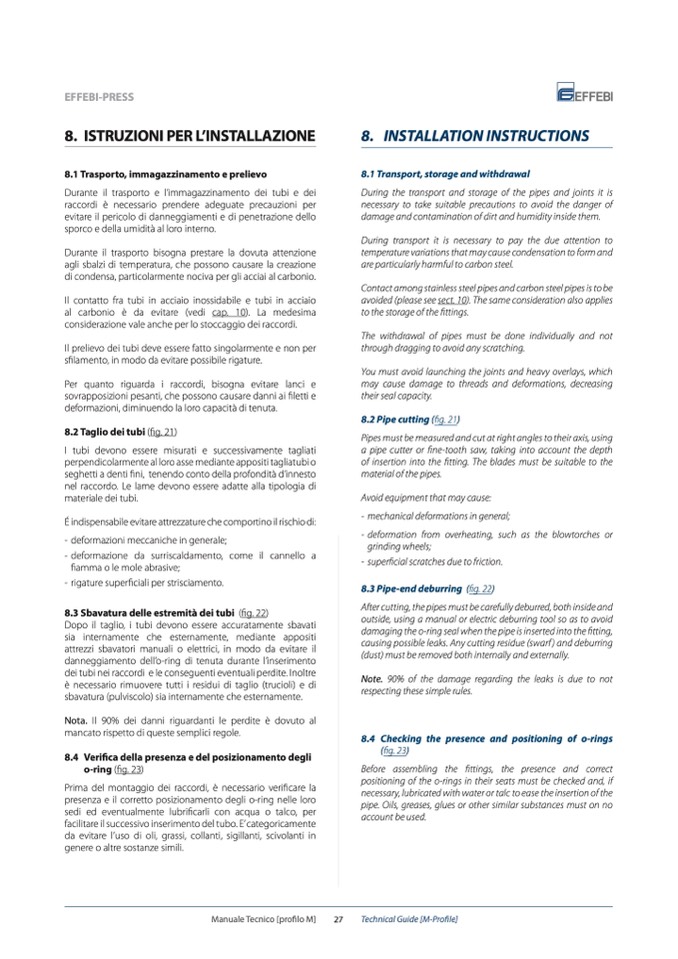
EFFEBI-PRESS
8. ISTRUZIONI PER L’INSTALLAZIONE
8.1 Trasporto, immagazzinamento e prelievo
Durante il trasporto e l’immagazzinamento dei tubi e dei
raccordi è necessario prendere adeguate precauzioni per
evitare il pericolo di danneggiamenti e di penetrazione dello
sporco e della umidità al loro interno.
Durante il trasporto bisogna prestare la dovuta attenzione
agli sbalzi di temperatura, che possono causare la creazione
di condensa, particolarmente nociva per gli acciai al carbonio.
Il contatto fra tubi in acciaio inossidabile e tubi in acciaio
al carbonio è da evitare (vedi cap. 10). La medesima
considerazione vale anche per lo stoccaggio dei raccordi.
Il prelievo dei tubi deve essere fatto singolarmente e non per
sfilamento, in modo da evitare possibile rigature.
Per quanto riguarda i raccordi, bisogna evitare lanci e
sovrapposizioni pesanti, che possono causare danni ai filetti e
deformazioni, diminuendo la loro capacità di tenuta.
8.2 Taglio dei tubi (fig. 21)
I tubi devono essere misurati e successivamente tagliati
perpendicolarmente al loro asse mediante appositi tagliatubi o
seghetti a denti fini, tenendo conto della profondità d’innesto
nel raccordo. Le lame devono essere adatte alla tipologia di
materiale dei tubi.
É indispensabile evitare attrezzature che comportino il rischio di:
- deformazioni meccaniche in generale;
- deformazione da surriscaldamento, come il cannello a
fiamma o le mole abrasive;
- rigature superficiali per strisciamento.
8.3 Sbavatura delle estremità dei tubi (fig. 22)
Dopo il taglio, i tubi devono essere accuratamente sbavati
sia internamente che esternamente, mediante appositi
attrezzi sbavatori manuali o elettrici, in modo da evitare il
danneggiamento dell’o-ring di tenuta durante l’inserimento
dei tubi nei raccordi e le conseguenti eventuali perdite. Inoltre
è necessario rimuovere tutti i residui di taglio (trucioli) e di
sbavatura (pulviscolo) sia internamente che esternamente.
Nota. Il 90% dei danni riguardanti le perdite
è dovuto al
mancato rispetto di queste semplici regole.
8.4 Verifica della presenza e del posizionamento degli
o-ring (fig. 23)
Prima del montaggio dei raccordi, è necessario veri
ficare la
presenza e il corretto posizionamento degli o-ring nelle loro
sedi ed eventualmente lubrificarli con acqua o talco, per
facilitare il successivo inserimento del tubo. E’categoricamente
da evitare l’uso di oli, grassi, collanti, sigillanti, scivolanti in
genere o altre sostanze simili.
8. INSTALLATION INSTRUCTIONS
8.1 Transport, storage and withdrawal
During the transport and storage of the pipes and joints it is
necessary to take suitable precautions to avoid the danger of
damage and contamination of dirt and humidity inside them.
During transport it is necessary to pay the due attention to
temperature variations that may cause condensation to form and
are particularly harmful to carbon steel.
Contact among stainless steel pipes and carbon steel pipes is to be
avoided (please see sect. 10). The same consideration also applies
to the storage of the fittings.
The withdrawal of pipes must be done individually and not
through dragging to avoid any scratching.
You must avoid launching the joints and heavy overlays, which
may cause damage to threads and deformations, decreasing
their seal capacity.
8.2 Pipe cutting (fig. 21)
Pipes must be measured and cut at right angles to their axis, using
a pipe cutter or fine-tooth saw, taking into account the depth
of insertion into the fitting. The blades must be suitable to the
material of the pipes.
Avoid equipment that may cause:
- mechanical deformations in general;
- deformation from overheating, such as the blowtorches or
grinding wheels;
- superficial scratches due to friction.
8.3 Pipe-end deburring (fig. 22)
After cutting, the pipes must be carefully deburred, both inside and
outside, using a manual or electric deburring tool so as to avoid
damaging the o-ring seal when the pipe is inserted into the fitting,
causing possible leaks. Any cutting residue (swarf ) and deburring
(dust) must be removed both internally and externally.
Note. 90% of the damage regarding the leaks is due to not
respecting these simple rules.
8.4 Checking the presence and positioning of o-rings
(fig. 23)
Before assembling the fittings, the presence and correct
positioning of the o-rings in their seats must be checked and, if
necessary, lubricated with water or talc to ease the insertion of the
pipe. Oils, greases, glues or other similar substances must on no
account be used.
Manuale Tecnico [profilo M]
27
Technical Guide [M-Profile]

